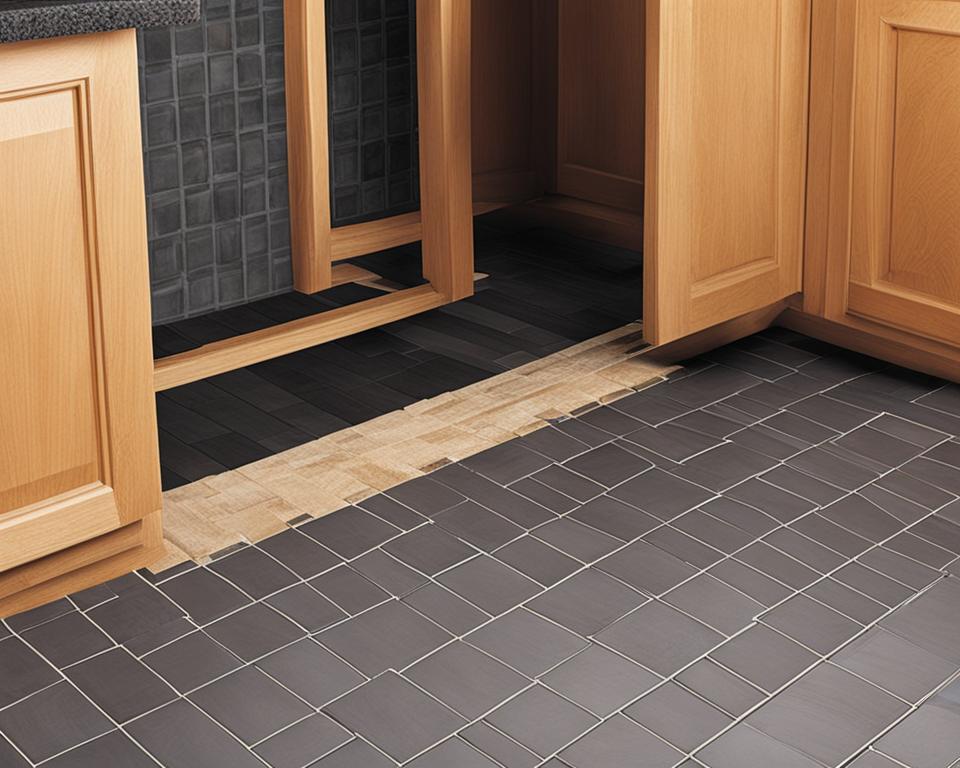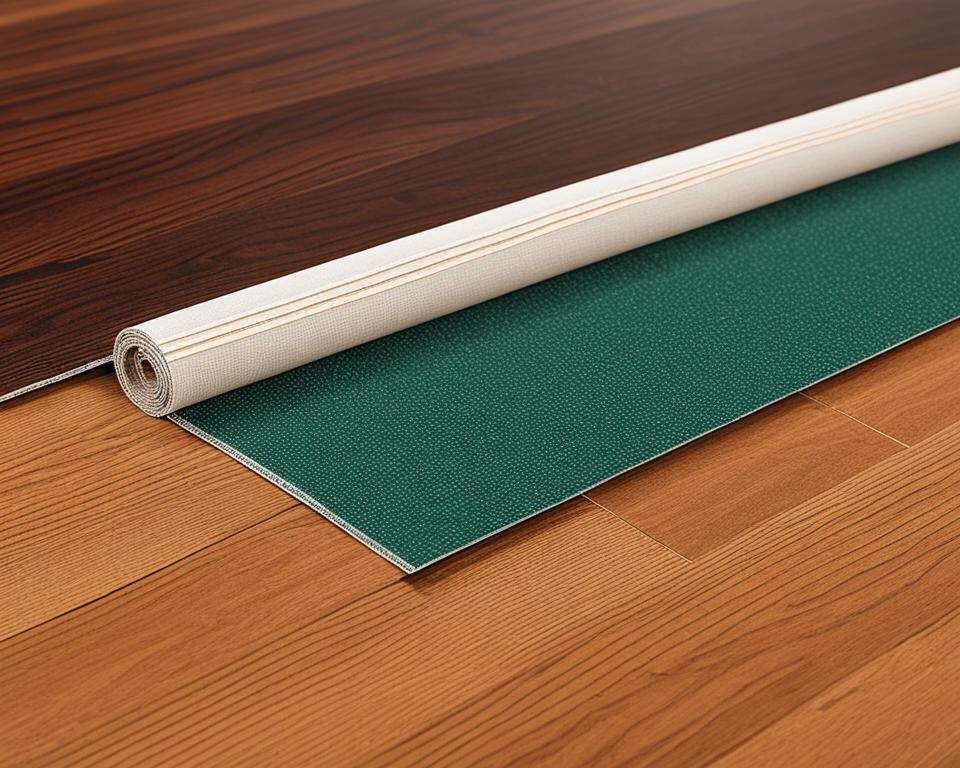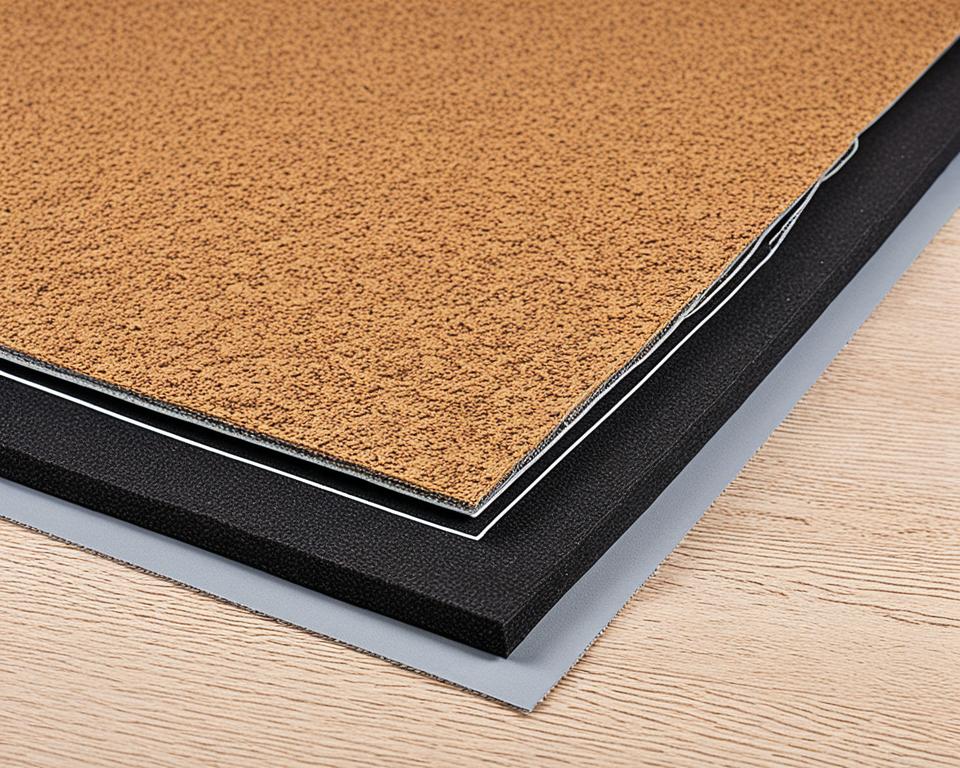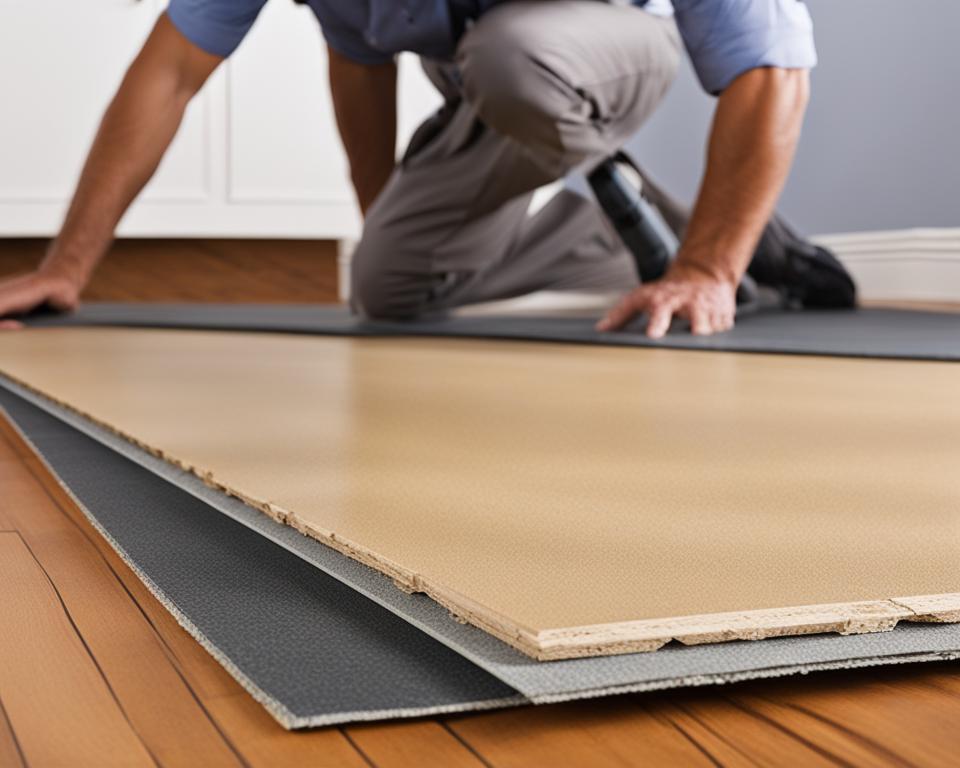When it comes to flooring, there are two essential components that play a crucial role in its stability and performance: underlayment and subfloor. While these terms are often used interchangeably, they serve different purposes in a flooring system. Understanding the differences between underlayment and subfloor is key to making informed choices for your flooring project.
Key Takeaways:
- Underlayment acts as a buffer between the floor covering and the subfloor, while the subfloor provides stability and support.
- The subfloor is typically made of plywood or OSB, while underlayment can be made of various materials such as plywood, cement backer board, or foam.
- Proper installation of the subfloor is crucial to prevent floor sagging and bounce, especially for tile installations.
- Underlayment serves different purposes depending on the type of flooring, such as smoothing out uneven subflooring for hardwood floors or providing moisture resistance for tile and stone flooring.
- Choosing the right underlayment involves considering factors like moisture resistance, noise reduction, and compatibility with the floor covering material.
The Role of Subfloor in Flooring Systems
When it comes to flooring systems, the subfloor plays a critical role in providing stability and support for the floor covering. Made of plywood or OSB, the subfloor is the flat, stable surface that lies beneath the visible layer of flooring. Proper subfloor installation is essential to ensure the longevity and performance of your floors.
The subfloor serves as a solid base for various types of floor coverings, including tile. For tile installations, a subfloor made of plywood or OSB with tongue-and-groove edges is commonly used. This type of subfloor provides a secure foundation and helps prevent floor sagging and bounce, which can occur over time if the subfloor is not sturdy enough.
To illustrate the importance of subfloor installation, consider the scenario of laying tile directly on an uneven or weak subfloor. Without a proper subfloor, the tiles may not adhere well, resulting in cracked or loose tiles in the future. Additionally, an inadequate subfloor can lead to an uneven surface, causing the tiles to appear uneven and compromising the overall aesthetic of the room.

By ensuring a solid subfloor installation, you can create a level and stable surface for your tile flooring. This will not only enhance the appearance of your floors but also contribute to their durability and lifespan.
| Benefits of a well-installed subfloor for tile: |
|---|
| 1. Provides a stable base for tile installation. |
| 2. Prevents sagging and bouncing of the floor surface. |
| 3. Reduces the risk of cracked or loose tiles. |
| 4. Ensures a level and even surface for the tiles. |
| 5. Improves the overall longevity and performance of the tile flooring. |
Understanding Underlayment and Its Purpose
Underlayment plays a crucial role in any flooring installation, acting as a thin buffer layer between the floor covering and the subflooring. It provides support, stability, and added benefits depending on the type of flooring being installed.
Types of Underlayment
There are various types of underlayment available, each designed to suit specific flooring needs. The choice of underlayment depends on factors such as the type of floor covering and the condition of the subflooring.
For hardwood floors, a thin luan or plywood underlayment is commonly used. It helps to smooth out any unevenness in the subflooring, creating a flat and level surface for the hardwood planks.
For wet applications like tile and stone flooring, a cement backer board is often used as underlayment. This moisture-resistant material provides a stable base and helps to prevent water damage.
In some cases, laminate flooring planks come with pre-attached underlayment. This can simplify the installation process and provide additional noise reduction and cushioning.
Underlayment for Hardwood Floors
When it comes to hardwood floors, selecting the right underlayment is crucial for ensuring optimal performance and longevity. The underlayment not only helps to create a smooth surface but also provides cushioning and sound absorption.
A popular choice for hardwood floors is a foam underlayment. This type of underlayment offers excellent cushioning and noise reduction properties, making it ideal for use in residential settings.
It is essential to consider the specific requirements of your hardwood flooring project. Some hardwood manufacturers may have specific recommendations for the type of underlayment to be used with their products.
Underlayment vs Padding
It is important to note the distinction between underlayment and padding. While underlayment provides support and moisture resistance, padding is specifically designed for adding cushioning and softness to carpeted areas.
When choosing underlayment, it is crucial to consider the flooring material and its specific requirements. Underlayment designed for carpet may not be suitable for tile or hardwood floors.
Consulting with flooring professionals and following manufacturer guidelines can help you select the appropriate underlayment for your specific flooring project.

| Underlayment Type | Features |
|---|---|
| Luan or Plywood Underlayment | Smooths out uneven subflooring, creates a level surface for hardwood floors |
| Cement Backer Board | Moisture-resistant, ideal for wet applications like tile and stone flooring |
| Foam Underlayment | Offers cushioning and noise reduction properties, commonly used for hardwood floors |
| Pre-attached Underlayment | Simplifies installation process, provides additional noise reduction and cushioning for laminate flooring |
Choosing the Right Underlayment for Your Flooring Project
When it comes to selecting the perfect underlayment for your flooring project, there are a few key factors to consider. Moisture resistance, noise reduction, and compatibility with the floor covering material are all important aspects that can impact the performance and longevity of your floors.
For hardwood floors, standard foam underlayment is a popular choice. It provides a cushioning effect and helps to reduce noise transmission between floors. However, it’s important to note that foam underlayment may not be suitable for moisture-prone areas, such as bathrooms or basements. In such cases, alternative options should be explored.
A great alternative to foam underlayment is cork. Cork underlayment offers excellent moisture resistance and provides natural sound absorption. It can help to reduce footfall noise and create a more peaceful environment. Additionally, cork has thermal insulation properties, making it a good choice for areas that experience temperature fluctuations.
When selecting underlayment, it’s crucial to consult manufacturer guidelines and recommendations that are specific to your flooring material. Different types of flooring may have different requirements when it comes to underlayment. Consulting these guidelines will ensure that you choose the most appropriate underlayment for your specific flooring project.
Comparative Underlayment Types
| Underlayment Type | Moisture Resistance | Noise Reduction | Compatibility |
|---|---|---|---|
| Foam | Good | Medium | Compatible with most flooring materials |
| Cork | Excellent | High | Compatible with most flooring materials |
| Plywood | Good | Low | Compatible with certain flooring materials |
As the table above illustrates, different underlayment types vary in terms of moisture resistance, noise reduction, and compatibility with flooring materials. Consider these factors carefully when making your selection.
By choosing the right underlayment for your flooring project, you can ensure optimal performance and longevity. Keep in mind the specific requirements of your project, consult manufacturer guidelines, and choose an underlayment that meets your needs. With the right underlayment, your floors will not only look great but also provide the comfort and durability you desire.

Conclusion
Understanding the differences between underlayment and subfloor is crucial when it comes to installing a flooring system that is durable, stable, and long-lasting. The subfloor, which forms the solid base, provides essential support for the floor covering. On the other hand, underlayment acts as a buffer and offers additional benefits such as moisture resistance and noise reduction.
When choosing underlayment, consider factors like moisture resistance, noise reduction, and compatibility with the floor covering material. Foam underlayment is commonly used for hardwood floors, but it may not be suitable for areas prone to moisture. Cork underlayment, on the other hand, provides excellent noise reduction and thermal insulation.
To achieve the best results, it is essential to select the right underlayment and install the subfloor correctly. By considering the specific requirements of your flooring project and consulting manufacturer guidelines, you can make informed choices and ensure the success of your installation. Remember, the correct combination of underlayment and subfloor is key to a well-functioning and beautiful flooring system.
FAQ
What is the difference between underlayment and subfloor?
The subfloor is the flat, stable surface below the floor covering, typically made of plywood or OSB. Underlayment, on the other hand, is a thin buffer layer between the floor covering and the subflooring, made of materials like plywood, cement backer board, or foam.
What is the role of the subfloor in flooring systems?
The subfloor provides a solid base for the floor covering, helping to prevent floor sagging and bounce. Proper installation of the subfloor is crucial for stability and longevity, especially for tile installations.
What is the purpose of underlayment in flooring?
Underlayment serves various purposes depending on the type of flooring being installed. It can smooth out uneven subflooring for hardwood floors or provide moisture resistance and noise reduction for wet applications like tile and stone flooring.
How do I choose the right underlayment for my flooring project?
Consider factors such as moisture resistance, noise reduction, and compatibility with the floor covering material. Standard foam underlayment is commonly used for hardwood floors, but cork is another popular option that provides added noise reduction and thermal insulation. Consult manufacturer guidelines for specific recommendations.
Why is it important to understand the differences between underlayment and subfloor?
Understanding these components is crucial for the successful installation of any flooring system. The subfloor provides a solid base, while underlayment acts as a buffer and can provide additional benefits such as moisture resistance and noise reduction. Proper selection and installation ensure durability, stability, and longevity of your flooring.
